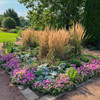Calamagrostis x acutiflora 'Lightning Strike'® - FEATHER REED GRASS 'LIGHTNING STRIKE'®
'Hello Spring' Reed Grass offers white creamy leaf centers.
Fresh sprouts have chartreuse tone. Purple flowers age to bronze-orange to tan.
Looks like variegated form of cultivar 'Karl Foerster'.
Great vertical structure and very long ornamental value from May to till you cut them down.
Adaptable, drought tolerant, tough and long-lived.
Good performer in Chicago Botanic Garden trials, gaining 3 stars out of 4.
Blooming Time: May to late fall
Size: 60" tall x 40" wide
USDA Zones: 4 to 8
Culture: full sun, half-sun, any soil (drier, sandy, gravely, rocky soils, clay, loam, average. Drought tolerant once established
Moisture Needs: dry, medium-dry, medium, medium-moist
Origin: hybrid of Asian species. Comes from division of Karl at Garden State Growers in Kettle Falls, WA ('Karl Foerster' is probably a natural hybrid between European Calamagrostis arundinacea and Asian Calamagrostis epigejos.
Attracts Butterflies or Pollinators: no
Attracts Hummingbirds: no, attracts small birds
Pot Size: 3.5" x 4" perennial pot (1.22 pt/580 ml)
Picture copyright :Reiman Gardens
Plant combinations: Versatile use grass - awesome in public spaces, private gardens, modern landscaping and modern architecture, but looks good in any flower bed in full sun, as a background for lower perennials, and naturalistic plantings or even cottage gardens or prairie type of gardens. Can be used in rain gardens, traffic islands. Can be combined with majority of common native and non-native perennials like Agastache, Amsonia, Aster, Asclepias, Baptisia, Calamintha, Callirhoe,Caryopteris, Chelone, Coreopsis, Echinacea, Eryngium, Liatris, Monarda, Penstemon, Perovskia, Phloxes, Physostegia, Ratibida, Rudbeckia, Silphium, Verbena, or other grasses like Schizachyrium scoparium, Sporolobus heterolepis, Stipa etc.

Calamagrostis x acutiflora 'Lightning Strike'® - FEATHER REED GRASS 'LIGHTNING STRIKE'®
'Hello Spring' Reed Grass offers white creamy leaf centers.
Fresh sprouts have chartreuse tone. Purple flowers age to bronze-orange to tan.
Looks like variegated form of cultivar 'Karl Foerster'.
Great vertical structure and very long ornamental value from May to till you cut them down.
Adaptable, drought tolerant, tough and long-lived.
Good performer in Chicago Botanic Garden trials, gaining 3 stars out of 4.
Blooming Time: May to late fall
Size: 60" tall x 40" wide
USDA Zones: 4 to 8
Culture: full sun, half-sun, any soil (drier, sandy, gravely, rocky soils, clay, loam, average. Drought tolerant once established
Moisture Needs: dry, medium-dry, medium, medium-moist
Origin: hybrid of Asian species. Comes from division of Karl at Garden State Growers in Kettle Falls, WA ('Karl Foerster' is probably a natural hybrid between European Calamagrostis arundinacea and Asian Calamagrostis epigejos.
Attracts Butterflies or Pollinators: no
Attracts Hummingbirds: no, attracts small birds
Pot Size: 3.5" x 4" perennial pot (1.22 pt/580 ml)
Picture copyright :Reiman Gardens
Plant combinations: Versatile use grass - awesome in public spaces, private gardens, modern landscaping and modern architecture, but looks good in any flower bed in full sun, as a background for lower perennials, and naturalistic plantings or even cottage gardens or prairie type of gardens. Can be used in rain gardens, traffic islands. Can be combined with majority of common native and non-native perennials like Agastache, Amsonia, Aster, Asclepias, Baptisia, Calamintha, Callirhoe,Caryopteris, Chelone, Coreopsis, Echinacea, Eryngium, Liatris, Monarda, Penstemon, Perovskia, Phloxes, Physostegia, Ratibida, Rudbeckia, Silphium, Verbena, or other grasses like Schizachyrium scoparium, Sporolobus heterolepis, Stipa etc.


